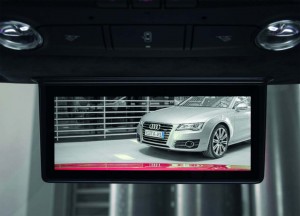Audi was facing a big problem as it finishes development of the new R8 e-tron. The battery-electric version of its 2-seat supercar has no back window – which makes it a little useless to offer a rearview mirror, at least a conventional one.
Instead, the maker is dipping into its motorsports tool kit to come up with the same digital “mirror” used on its R18 endurance racer, the same vehicle that recently won LeMans. An advanced, 7.7-inch organic LED screen will effectively recreate the image of a traditional rearview mirror – while adding in a few neat, high-tech tricks, such as the ability to block the glare from headlights.
Rear-mounted cameras have become commonplace in today’s cars, helping motorists safely back out of parking places. But the Audi system won’t simply move the image from the center stack-mounted navi screen to the mirror. The R8 e-tron will provide a much more detailed and more accurate image than available from current backup cameras.
It will rely on a special camera hidden in an “aerodynamically optimized” upper housing at the back of the car, positioned to give the same basic viewing angle as a real rearview mirror – though it will also offer a wider field of view. The tiny lens, which Audi says measures “just a few millimeters,” will be protected from dust and other debris. The camera itself, meanwhile, will be heated in winter to ensure it can operate under all weather conditions.
The display will measure roughly the same size as a conventional mirror and will rely on a technology called AMOLED, or Active Matrix Organic Light Emitting Diodes, an advanced system that is thinner and more efficient than conventional LED and LCD displays. Widely used in small consumer electronic devices, such as cellphones, it is just being introduced in larger formats.
AMOLEDs produce especially bright and sharp images and handle motion better than standard LED monitors, something particularly appealing in an automotive application.
The Audi system will auto dim at night, electronically adjust the image in poor lighting situations and to reduce glare from the headlights of vehicles behind. The maker suggests it is “is also working on incorporating additional information on the monitor in future.” That could mean adding the sort of performance information some makers now present to the driver through head-up display, or HUD, systems.
The digital rearview mirror made its debut on the R18 e-tron Quattro, a hybrid racecar that helped Audi scurry to a one-two-three win during the recent 24 Hours of Le Mans.
Automakers have been toying with the idea of replacing mirrors with video displays for a number of years. Any number of concept cars have used the technology as a sleeker alternative to sideview mirrors, in particular, as a pencil-thin camera generates far less aerodynamic resistance – or wind noise – than a conventional, door-mounted mirror.
But, until now, the technology has had to stay on the show floor due to both cost constraints and government safety restrictions. So far, the National Highway Traffic Safety Administration has not approved the technology for production vehicles.
Whether Audi will be able to get the go if it brings the R8 e-tron to the U.S. remains to be seen. The battery-electric supercar is expected to go into limited production late this year.

